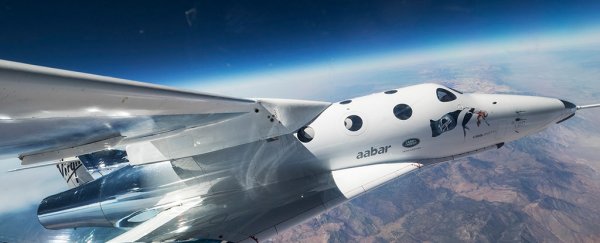"Space is hard - but worth it," Richard Branson wrote after Virgin Galactic's SpaceShipTwo crashed in October 2014, killing one of the pilots. Now the company is making good on that mantra, having launched its first test flight since the tragic incident.
The brand-new VSS Unity, the latest SpaceShipTwo craft to roll off the production line, flew for nearly 4 hours across the Californian desert earlier this week, as you can see in the video below.
The whole journey was what's called a 'captive carry' flight, with Unity remaining tethered to a mothership aircraft from take-off to landing. It allowed Virgin Galactic's experts to check how the spacecraft reacts to wind flow and low temperatures - the tethering effectively creates a flying wind tunnel environment.
"With this flight in the books, our team will now analyse a mountain of flight data, learning what worked well and what could be improved for our next flight test," explains the Virgin Galactic blog.
"Our first flight test was an emotional and fulfilling moment for our hardworking team, even as we recognise how much work we have yet to do."
Virgin Galactic is obviously going slow this time around, taking on more responsibility for the production of the newest SpaceShipTwo craft, and scheduling a rigorous round of test flights before VSS Unity will be open for business.
The VSS Unity was named by Stephen Hawking, who also has his name down to be one of the first to take the journey to the edge of our atmosphere.
Eventually, it's hoped that the craft will be able to take six passengers at a time (plus two pilots) to the edge of space and back again, for an up-front ticket cost of US$250,000. So far, there's no estimate for when commercial flights might get off the ground.
Following the fatal events of October 2014, a nine-month investigation into the cause of the crash found that one of the pilots had unlocked the braking system too early, but the spacecraft should have had safety features in place to guard against such an error.
Those mistakes cost pilot Michael Alsbury his life. His fellow pilot, Peter Siebold, who parachuted back down to Earth, was left with serious injuries. Let's hope that, as with previous tragedies, such as the Challenger disaster, lessons can be learned to make spaceflight safer in the future.
This week's test flight comes on the back of Virgin Galactic being awarded an operating licence by the US Federal Aviation Administration (FAA) last month - although it's dependent on the SpaceShipTwo craft meeting a list of strict rules and regulations, and going through a tough testing program.
Blue Origin, led by Amazon CEO Jeff Bezos, has a similar space tourism plan underway, with the goal of giving ordinary civilians like us the chance to travel up to the edge of space.
Despite the serious accidents that happen along the way - like the recent rocket explosion that may ground SpaceX for up to 12 months - the quest to explore the galaxy continues.
And thanks to the pioneers leading the way, it's going to be a much safer experience when the rest of us get up there.
